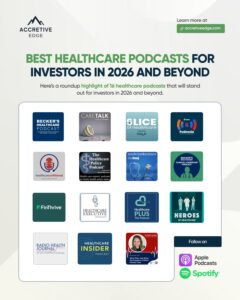Why Good Healthcare Market Research Actually Drives Revenue
For many early-stage digital health founders, market research lives in the category of “things we know we should do.” But when the pressure to build quickly and show traction kicks in, it often becomes one of the first things to get de-scoped. Especially if the team already has a strong point of view on the problem.
That instinct is understandable. But it’s also expensive.
Skipping structured research doesn’t just mean you might miss an insight. It means you might build for the wrong buyer, enter the wrong segment, or shape your messaging around what sounds good to you — rather than what actually lands.
And in healthcare, those kinds of mistakes carry a different weight. You’re not just navigating user preferences — you’re up against clinical workflows, incentive structures, budget cycles, and governance models that don’t move quickly or tolerate ambiguity.
Structured research is what turns that ambiguity into traction. As Harvard Business School puts it, the path to product-market fit starts with effective market research — not pitch decks or MVPs, but signal from the field.
You don’t need a 50-page report. What you need is real-world signal needed to:
- Focus on the right segment
- Solve a problem with budget behind it
- Position your solution in language buyers already use
- Reduce churn by getting adoption right the first time
This article walks you through 6 specific ways digital health market research drives early-stage revenue in practice.
1. Pinpoint the Right Buyer Segments (and Know Who to Ignore)
Many early-stage go-to-market mistakes don’t stem from bad messaging or pricing — they often come from aiming at the wrong buyer.
Healthcare doesn’t have a single buyer. It has users, influencers, gatekeepers, and budget holders — and they rarely sit in the same role. Without structured research, teams often default to broad labels like “primary care” or “hospital systems.” But those are too vague for real targeting. They don’t reveal where the urgency lies, who owns the budget, or who’s likely to take action.
Structured healthcare market research helps narrow the focus. It encourages teams to separate who uses the solution from who funds it — and from who feels the pain most directly.
Say your product supports post-visit care coordination. Who owns that? A care manager? A VP of population health? A quality lead? Each has different priorities. Without stakeholder-specific interviews, it’s hard to know who sees your product as critical — and who sees it as extra work.
The U.S. Small Business Administration says market research exists to help you “find the customers for your business.” In healthcare, that means digging deeper: not just which organizations, but which roles are most likely to support, fund, and champion your solution.
You don’t need a giant market map. But you do need structured inputs — interviews across segments, real conversations with decision-makers, and clarity about who has the most to gain.
Otherwise, outreach feels like throwing spaghetti at the wall. And in healthcare, those walls are expensive.
2. Validate Real Needs and Prevent Misalignment
Early-stage teams often run on conviction — sometimes a little too much.
It’s easy to fall in love with a problem, workflow, or piece of technology. But conviction without validation can lead to costly detours. When you build on assumptions instead of real signals, you risk spending months on features no one uses — or solving a problem that doesn’t really matter to your buyer.
This isn’t a failure of effort or vision. It’s a common pattern — and the data backs it up.
The top-cited reason for startup failure? “No market need.” That accounts for 42% of postmortems. In digital health, the picture is even more sobering: 98% of startups face serious challenges, with many struggling or failing due to misreading real problems, according to Forbes.
Healthcare user research helps reduce that risk. It’s not about asking, “Would you use this?” It’s surfacing specific, verifiable pain:
- What’s slowing them down?
- What’s linked to incentives or penalties?
- What’s been tried before — and why didn’t it stick?
Good research surfaces not just the problem, but the urgency behind it. You’re looking for signs like “We need a better way to do this,” or “This is on our radar next quarter.” Budget signals and workflow hurdles are also worth listening for — before you start building.
Research also helps you triangulate. If five stakeholders give five different answers about the same problem, that may point to organizational complexity. It could mean you’re too early — or that you’re targeting the wrong layer of the problem.
Early-stage validation doesn’t mean your idea is bulletproof. It just means there’s a clear problem, buyers care about it, and your solution might reasonably fit their workflow and budget.
The alternative? A well-built product that never finds traction.
3. Shape Messaging That Converts
Even when a startup solves a real problem, deals still stall — not because the solution isn’t valuable, but because it doesn’t look valuable enough from where the buyer sits.
That often comes down to messaging. And most early-stage messaging reflects the founder’s perspective, not the buyer’s.
Structured research flips that. It gives you healthcare customer insights — how the buyer talks about the problem, what outcomes matter most, and what phrasing sparks interest versus indifference. When you hear that “automates care coordination” doesn’t land, but “helps our nurses get an hour back in their day” gets heads nodding — that’s commercial insight.
Founders often default to feature lists. Buyers respond to prioritized outcomes. That distinction is subtle, but expensive when ignored.
Example:
- A Chief Medical Officer may care about quality metrics tied to CMS reporting.
- A nurse manager may care about how your tool affects patient throughput and staff turnover.
- A CFO may care whether your implementation model exposes them to risk this fiscal year.
It’s hard to tailor the right message unless you’ve heard their priorities in their own words. This shows up in the details:
- Cold outreach that actually sounds human.
- Demos framed around what others in their shoes have said.
- Sales decks built around the buyer’s pain — not the founder’s background.
Messaging shaped by real insights doesn’t just sound better. It tends to shorten sales cycles and reduce dropout — because buyers hear themselves in the pitch.
4. Inform Go-to-Market Strategy and Positioning
Building a strong solution is one thing. Figuring out where to take it first — and how to get it bought — is another.
A key part of go-to-market strategy is sequencing: deciding which segment to target first, which roles to engage, what sales motion to run, and how to avoid spending time on pilots that rarely convert.
Digital health market research can help provide the inputs to make those choices with more signal and less guesswork.
For instance, if you’re choosing between large health systems and independent physician groups, research can help you assess:
- Which group has more financial urgency around the problem?
- Who’s tried something similar — and what shaped the outcome?
- Where is the path of least resistance — contracting, workflow, or adoption?
Founders sometimes treat go-to-market as a one-size-fits-all plan. But in practice, what works in one care setting can fall flat in another. A chronic care tool might resonate with ACO-aligned primary care groups but miss the mark with urgent care. A documentation product could feel essential in nursing homes but unnecessary in hospitals with EHR customizations.
Research helps clarify not just who your solution is for, but the context that makes it viable. And that extends to positioning.
When you understand how buyers describe their current challenges — what frustrates them, what they’ve tried, where they feel risk — you’re less likely to default to “We’re like [x] but better.” Instead, you can position by removing friction, not just adding features.
That’s often the difference between being interesting and being essential.
5. Build Investor and Advisor Credibility
Founders often underestimate how visible it is when they’re guessing.
In investor meetings, early advisory calls, and pilot negotiations, the difference between “we think” and “we’ve heard” becomes the difference between being seen as insightful or unprepared. Market research closes that gap.
When you walk into a pitch and say, “We interviewed thirty care managers across five systems — here’s what 70% of them flagged as the real bottleneck,” you’re not just showing market knowledge. You’re showing discipline. And that’s what early investors look for: not just vision, but signal.
The same applies to advisors and analysts. Most industry insiders aren’t swayed by a polished pitch. They want to know whether you’ve done the work to understand the system you’re trying to sell into.
When you can reference pilot feedback, procurement blockers, or healthcare customer insights like segment-specific willingness to pay, they know you’re not starting from zero — and that makes them more likely to make intros, co-develop partnerships, or stick around when things get hard.
You don’t need a slide deck full of survey data. But you do need proof that what you’re building reflects more than your own opinion.
Healthcare market research gives you the raw material to earn that trust.
6. Accelerate Adoption and Retention
Even when a deal gets signed, risk doesn’t go away. It just shifts — from the buyer’s hands to yours.
If your solution doesn’t work the way they expected, or if it adds friction to their workflow, the most likely outcome isn’t churn — it’s abandonment. Especially in clinical settings, where time is tight and the margin for error is thin, adoption risk is often more fatal than pricing friction.
This is where early-stage research pulls double duty. It doesn’t just help you win the deal. It helps you deliver on it.
When you apply healthcare user research to real workflows — not just pain points, but “who actually logs in,” “who documents,” “who follows up” — you start to see the operational landscape your solution has to fit into. You hear about staff shortages, alert fatigue, BYOD policies, or legacy workarounds that shape whether your product gets used the way you intended.
Founders who skip this step end up backfilling after the fact — with custom onboarding, rushed enablement materials, or support cycles that burn their earliest references.
But when you’ve done the research, you can build and deploy in a way that actually fits how care gets delivered. That means smoother launches, higher usage, and more leverage when it’s time to expand or renew.
A good UX helps, but the real key to adoption is whether the solution fits existing workflows. Research helps to show you where and how it needs to fit.
Market Research Is a Sales Tool — Not a Side Project in Digital Health
Many founders treat research as something that happens early — before the product, or before the raise. But the teams that move fastest on revenue tend to treat research differently: not as a side project, but as a core part of go-to-market.
Not because it guarantees success. But because it shortens the path to it.
When you understand the actual pain, the real buyer, workflow constraints, and messaging that lands — you don’t just get clearer. You get faster. Your outreach improves, pilots convert, roadmap stops wandering, and early customers are more likely to adopt, renew, and refer.
None of that happens by guessing.
At Accretive Edge, this is where I spend most of my time with founders — turning early research into a go-to-market plan that buyers can say yes to. Not a theoretical strategy, but something you can actually execute on with the team you have today.
If your solution is strong but revenue is lagging, it’s rarely about effort. It’s usually about direction. And digital health market research is what gives you that — with enough specificity to act.
So if you’re still making calls, testing decks, and trying to figure out where your first ten deals come from — this is the work. And you don’t have to do it alone.






